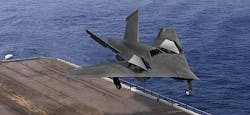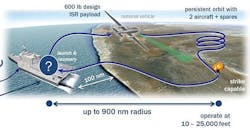Solicitation released for TERN program to operate long-endurance UAVs from small ships
ARLINGTON, Va., 1 April 2013. Military researchers have released a formal solicitation for an effort to develop a medium-altitude long-endurance unmanned aerial vehicle (UAV) for long-term maritime surveillance that can launch and recover from relatively small ships to provide airborne intelligence, surveillance, and reconnaissance (ISR) and strike mobile targets anywhere, around the clock.
Scientists at the U.S. Defense Advanced Research Projects Agency (DARPA) in Arlington, Va., released a broad agency announcement last week (DARPA-BAA-13-28) for first phase of the Tactically Exploited Reconnaissance Node (TERN) program, which seeks to develop technology to enable small ships to serve as mobile bases for UAVs. DARPA experts briefed industry on the TERN program objectives on 20 March.
The TERN program seeks to overcome limitations of Navy shipboard aircraft surveillance. Helicopters are relatively limited in their maximum distances and flight times, for example, while fixed-wing manned and unmanned aircraft must operate from aircraft carriers or large land bases with long runways, although they can fly farther and longer than helicopters.
The goal of TERN Phase I is to conduct design studies for an operational TERN UAV design, and plan for a prototype flight demonstration in 2017. For the program's initial phase, DARPA officials say they expect to award several contracts totaling as much as $8.9 million.
The TERN program seeks to combine the strengths of aircraft bases on land and sea, by using small ships as mobile launch and recovery sites for medium-altitude long-endurance (MALE) fixed-wing UAVs.
The ultimate goal for a TERN UAV and launch system to enable persistent intelligence, surveillance, and reconnaissance (ISR) and strike capabilities with payloads of 600 pounds while operating at ranges as long as 900 nautical miles from a host vessel.
The TERN system should be able to operate from several relatively small ship types in rough seas, including the 2,784-ton Independence-class littoral combat ship (LCS), which is 418 feet long and 104 feet wide, with a large aft-located flight deck. Other ships of interest are amphibious transport docks, dock landing ships, and Military Sealift Command cargo ships.
The program will produce a low-cost TERN prototype UAV to demonstrate launch, recovery and enabling technologies.
DARPA plans to roll out TERN in three phases over three or four, culminating in a full-scale launch and recovery demonstration. The first phase will include concept definition activities; the second phase will mature technology, with preliminary design, and the last phase will demonstrate a TERN prototype.
The current solicitation is for the first phase only. A second solicitation will be issued during Phase I to Phase I performers for Phase II and III work. The second and third phases of the TERN program will be worth about $42 million, DARPA officials say.
For the program's first phase, DARPA officials are interested most in novel launch and recovery techniques; aircraft navigation; ship motion prediction; high lift devices; high stroke recovery or arrestment devices; and compact stowage arrangements. Other technologies of interest include automated maintenance systems; robotic deck handling; automated vehicle preflight checkout.
TERN envisions UAV systems for deep overland ISR and strike missions without forward basing or host nation help. Long radius of action enables access to remote geographic areas while long endurance enables persistent ISR and striking fleeting targets.
A relatively small ship deploying with two or more UAVs could offer high tempo ISR and strike operations on an as-needed basis, DARPA officials say. Helicopters and airships should not be considered.
Named after the family of sea birds known for flight endurance, TERN aims to make it much easier, quicker and less expensive for the U.S. military to deploy ISR and strike aircraft almost anywhere in the world, DARPA officials say.
DARPA will ask industry to develop a MALE UAV and an automated launch and recovery system. The UAV would must be able to carry a 600-pound payload and fly as far as 600 to 900 nautical miles from its host vessel.
The launch and recovery system must fit a U.S. Navy Independence-class littoral combat ship (LCS-2) and other surface warships as feasible, DARPA officials say.
The TERN program envisions a capability "like having a falcon return to the arm of any person equipped to receive it, instead of to the same static perch every time,” says Daniel Patt, the DARPA TERN program manager.
“About 98 percent of the world’s land area lies within 900 nautical miles of ocean coastlines," Patt explains. "Enabling small ships to launch and retrieve long-endurance UAVs on demand would greatly expand our situational awareness and our ability to quickly and flexibly engage in hotspots over land or water.”
Key technical challenges include devising a reliable launch and recovery technique to enable large aircraft to operate from small ships, even in rough seas; designing an aircraft with range, endurance, and payload comparable to emerging land-based unmanned aircraft with minimal ship modifications; and packaging the system to fit into the limited space aboard ships.
Limited-duration employment may open the door to novel design approaches, extensive content re-use, design alternatives, materials, and maintenance not typically considered for maritime aircraft. Offerors should consider TERN designs that involve a UAV able to act as a payload-agnostic “mission truck,” DARPA officials say.
Companies interested should submit proposals by 10 May 2013, although DARPA may evaluate proposals submitted over the next six months. Send proposals to DARPA/TTO; ATTN: DARPA-BAA-13-28; 675 North Randolph St.; Arlington, VA 22203-2114. No e-mailed or faxed proposals will be accepted.
Companies that have shown interest in participating in the TERN program thus far include AeroVironment; Aurora Flight Sciences; Austal USA; BAE Systems; Boeing; General Atomics; Insitu; L-3 Communications; Lockheed Martin; Logos Technologies; Northrop Grumman; Raytheon; ReconRobotics; Rockwell Collins; Science Applications International Corporation; Sierra Nevada Corp.; Sikorsky; Space Systems/Loral; and Teledyne.
Email DARPA for questions or concerns at [email protected].
More information is online at https://www.fbo.gov/spg/ODA/DARPA/CMO/DARPA-BAA-13-28/listing.html.


